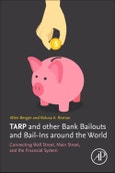Financial crises are recurring phenomena that result in the financial distress of systemically important banks, making it imperative to understand how to best respond to such crises and their consequences. Two policy responses became prominent for dealing with these distressed institutions since the last Global Financial Crisis: bailouts and bail-ins. The main questions surrounding these responses touch everyone: Are bailouts or bail-ins good for the financial system and the real economy? Is it essential to save distressed financial institutions by putting taxpayer money at risk in bailouts, or is it better to use private money in bail-ins instead? Are there better options, such as first lines of defense that help prevent such distress in the first place? Can countercyclical prudential and monetary policies lessen the likelihood and severity of the financial crises that often bring about this distress? Through careful analysis, authors Berger and Roman review and critically assess the extant theoretical and empirical research on many resolution approaches and tools. Placing special emphasis on lessons learned from one of the biggest bailouts of all time, the Troubled Asset Relief Program (TARP), while also reviewing other programs and tools, TARP and Other Bank Bailouts and Bail-Ins around the World sheds light on how best to protect the financial system on Wall Street and the real economy on Main Street.
Please Note: This is an On Demand product, delivery may take up to 11 working days after payment has been received.
Table of Contents
I Introductory materials1. Introduction to bank bailouts, bail-ins and the related topics covered in the book2. Conditions that generally bring about bank bailouts, bail-ins, and other resolution methods3. Descriptions of the TARP program, other bank bailouts and bail-ins, and other resolution approaches in the United States and around the world4. Theoretical background on bank bailouts, bail-ins, and other resolution approaches
II Empirical research on TARP5. Methodologies used in most of the TARP empirical studies6. Determinants of applying for and receiving TARP funds and exiting early from the program7. Effects of TARP on recipient banks' valuations8. Effects of TARP on market discipline9. Effects of TARP on bank leverage risk10. Effects of TARP on bank competition11. Effects of TARP on bank credit supply12. Effects of TARP on bank portfolio risk13. Effects of TARP on recipient banks' credit customers14. Effects of TARP on the real economy15. Effects of TARP on systemic risk
III Empirical evidence bank bailouts other than TARP, bail-ins, and other resolution approaches16. Empirical research on bailouts other than TARP17. Empirical research on bail-ins18. Empirical research on other resolution approaches
IV First lines of defense to help avoid bailouts, bail-ins, and other resolutions19. Mechanisms for the first lines of defense20. Capital requirements21. Liquidity requirements22. Stress tests23. Prudential regulatory activity restrictions24. Prudential supervision25. Deposit insurance26. Direct government ownership of banks
V Looking toward the future27. Social costs and benefits28. Implications for bank policymakers and bank managers29. Open research questions to be addressed by future research
Authors
Allen N. Berger Professor in Banking and Finance, University of South Carolina, President, Financial Intermediation Research Society, Senior Fellow, Wharton Financial Institutions Center, and Fellow of the European Banking Center, SC, USA. Allen N. Berger is H. Montague Osteen, Jr., Professor in Banking and Finance at the University of South Carolina, President of the Financial Intermediation Research Society, Senior Fellow at the Wharton Financial Institutions Center, and Fellow of the European Banking Center.He has published over 125 articles in refereed journals, including in top finance journals, Journal of Finance, Journal of Financial Economics, and top economics journals, Journal of Political Economy and American Economic Review. He is co-author of two research books and co-edited all three editions of the Oxford Handbook of Banking. He serves on nine journal editorial boards, co-edited eight special issues of research journals, and formerly edited the Journal of Money, Credit, and Banking.
His research has been cited over 90,000 times, including 30 articles with over 1,000 citations each, and another 19 with over 500 citations each. He has given invited keynote addresses on five continents. Raluca A. Roman Senior Economist, Federal Reserve Bank of Philadelphia; formerly Federal Reserve Bank of Kansas City, KS, USA. Raluca A. Roman is Senior Economist at the Federal Reserve Bank of Philadelphia, and formerly at the Federal Reserve Bank of Kansas City. She holds a Ph.D. in Finance from University of South Carolina. Her research areas include banking and financial institutions consumer finance, corporate finance, and international finance. She has published articles in the Journal of Financial and Quantitative Analysis, Management Science, Journal of Financial Intermediation, Journal of Money, Credit, and Banking, Financial Management, Journal of Corporate Finance, Journal of International Money and Finance, Journal of Banking and Finance, and has received four awards for her papers at conferences. She also co-authored the book TARP and other Bank Bailouts and Bail-Ins around the World: Connecting Wall Street, Main Street, and the Financial System (2020, Elsevier). Raluca has presented her research and discussed the research of others at numerous finance and regulatory conferences.








